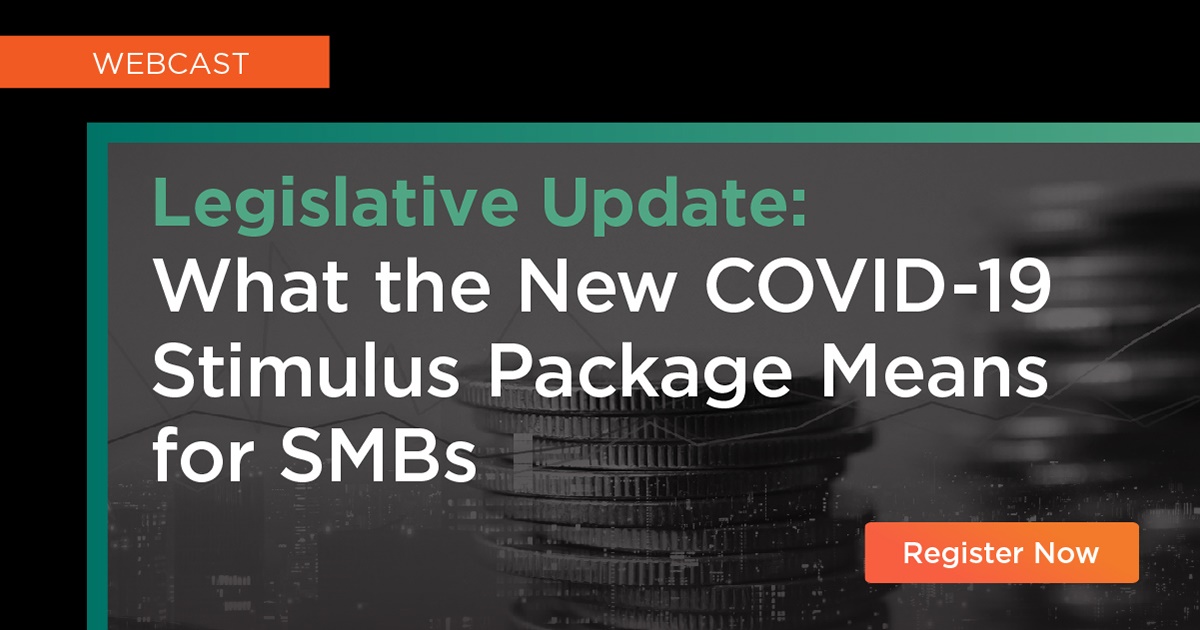The New COVID-19 Stimulus Package: What it Means for Small and Medium-Size Businesses

Table of contents
- 1.PPP Changes and the New PPP “Second Draw” Loans
- 2.Employee Retention Tax Credits
- 3.Other Tax and Unemployment Assistance Changes
In a long-awaited move, Congress passed a sweeping new COVID-19 stimulus package last week. It was signed by President Trump on Sunday night. There are important provisions for small and medium-size businesses (SMBs) that are covered in this blog.
The $900 billion stimulus package was combined with an omnibus spending package, the Consolidated Appropriations Act of 2021, to fund the federal government through the end of the current fiscal year, September 30, 2021. This latest stimulus, provides for a new round of funding for the Paycheck Protection Program (PPP), creates a process for small businesses to receive a second round of PPP loans (“second draw”), extends the Employee Retention Tax Credit and the Families First Coronavirus Response Act credits, and makes other significant changes to the PPP program. Congress has directed the Small Business Administration (SBA) to issue implementing regulations within 10 days of enactment so there will be additional details forthcoming.

PPP Changes and the New PPP “Second Draw” Loans
As part of the stimulus package, the Economic Aid to Hard-Hit Small Businesses, Nonprofits and Venues Act (the “Act”), appropriates $284.5 billion dollars to reopen the PPP loan program for first-and second-time borrowers and extends the program until March 31, 2021. The Act sets aside $35 billion for first time borrowers, $15 billion of which is to be applied to loans for smaller businesses with 10 or fewer employees, or loans of less than $250,000 in low-income areas and $25 billion for second draw PPP loans for smaller borrowers with 10 or fewer employees, or loans less than $250,000 in low-income areas.
The second draw provisions will enable a small business to receive a second PPP loan of up to $2 million if the small business has less than 300 employees, has used or will use the full amount of the first PPP loan, and can demonstrate a revenue reduction of 25 percent as determined by gross receipts during the first, second, third or, only with respect to loan applications submitted on or after January 1, 2021, the fourth quarter in 2020, as compared to the same quarter in 2019. In general, borrowers may receive a loan amount of up to 2.5 times the average monthly payroll costs in the one year prior to the loan or calendar year.
For loans of $150,000 or less, borrowers may submit a certification attesting that the borrower meets the revenue loss requirements. Non-profits and veterans’ organizations may utilize gross receipts to calculate their revenue loss standard.
The Act creates a simplified PPP loan forgiveness application for loans of $150,000 or less. The borrower is required to sign and submit a one-page certification that lists the loan amount, the number of employees the borrower was able to retain because of the loan, and the estimated total amount of the loan spent on payroll costs. No additional documentation may be requested. The SBA is directed to create this form within 24 days of enactment of the Act.
Other PPP loan changes include: expansion of the list of funds that qualify for loan forgiveness to include covered operations, property damage costs due to public disturbances that occurred during 2020 that are not covered by insurance, covered supplier costs, and covered worker protection expenditures including Personal Protective Equipment (PPE); expansion of payroll costs to include group life, disability, vision or dental insurance; permitting borrowers whose loan calculations have increased due to changes in interim final rules to work with lenders to modify their loan amount regardless if the loan has been fully disbursed.
Significantly, the Act clarifies Congressional intent that deductions are allowed for otherwise deductible expenses paid with proceed of a PPP loan that is forgiven; repeals the CARES Act provision that requires PPP borrowers to deduct their Economic Injury Disaster Loan (EIDL) loan advance from their PPP loan forgiveness amount; requires the SBA to issue rules that ensure that borrowers are made whole if they received forgiveness and their EDIL was deducted from that amount; and permits EDIL borrowers to also apply for a PPP loan.
Employee Retention Tax Credits
Other provisions of the stimulus package include the extension of the Employee Retention Tax Credit (ERTC) for wages paid through June 30, 2021.
The changes also expand the ERTC program by:
- Increasing the ERTC credit from 50% to 70% of qualified wages
- Increasing the per-employee wages subject to the ERTC credit from $10,000 total to $10,000 per calendar quarter
- Decreasing the gross receipts decline threshold for claiming ERTC credits from a 50% decline to a 20% decline, and
- Expanding the full range of ERTC credit options, including advance payments, for “small employers” from businesses with up to 100 employees up to businesses with up to 500 employees.
In addition, the stimulus package eliminates certain restrictions on the ERTC program for businesses that have a PPP loan. The ERTC is now available to businesses who receive a PPP loan so long as the same wages are not used for PPO loan forgiveness and ERTC credits.
Other Tax and Unemployment Assistance Changes
Other tax assistance provisions of the stimulus package include:
- Extending tax credits for paid sick and family leave under the Families First Coronavirus Response Act (FFCRA) through March 31, 2021, but with no FFCRA leave mandate after December 31, 2020
- Extending paid family and medical leave employer tax credit options under the 2017 tax reform bill (Section 45S credits)
- Expanding Section 127 student loan repayment benefits under the CARES Act,
- Extending until 2025 the availability of certain work opportunity tax credits (WOTC) for qualifying employers
- Providing another round of up to $600 direct stimulus payments
- Providing an extra unemployment benefit of $300 per week from December 26, 2020 to March 14, 2021.
TriNet will continue to provide updates on the new COVID-19 stimulus package and will host a webinar on Thursday, January 7 at 12pm PT/ 3pm ET to provide additional insight and answer some of your most pressing questions. Click here to register for the webinar.
In the meantime, you can visit the TriNet COVID-19 Preparedness Center for critical and up-to-date information as well as the impact of changing regulations on small and medium-size businesses. We continue to monitor the COVID-19 situation and provide updates as necessary.
This communication is for informational purposes only; it is not legal, tax or accounting advice; and is not an offer to sell, buy or procure insurance.
This post may contain hyperlinks to websites operated by parties other than TriNet. Such hyperlinks are provided for reference only. TriNet does not control such websites and is not responsible for their content. Inclusion of such hyperlinks on TriNet.com does not necessarily imply any endorsement of the material on such websites or association with their operators.

Greg Kerber
Table of contents
- 1.PPP Changes and the New PPP “Second Draw” Loans
- 2.Employee Retention Tax Credits
- 3.Other Tax and Unemployment Assistance Changes





